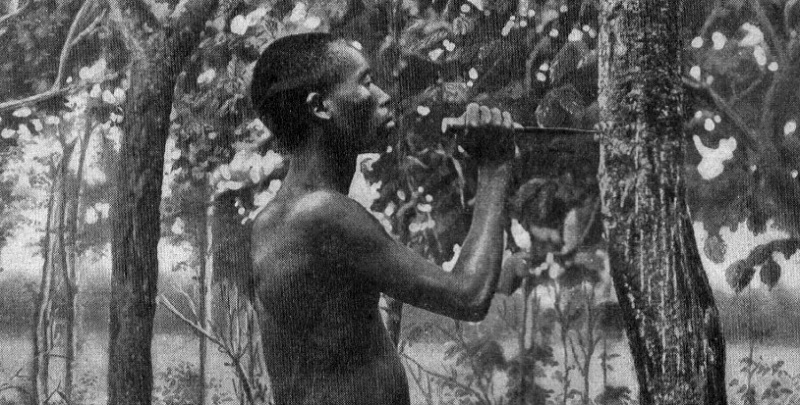Introduction to Bayonets of the Imperial German Colonial and Overseas Forces
The Imperial German army, navy and
colonial forces used several different models of bayonet (Seitengewehr). Usually
new models of bayonet were issued along with new models of rifle.
Bayonets were carried by most dismounted (and some mounted) troops in
colonial service up to and including the rank of Sergeant. Officers
and NCOs above the rank of Sergeant were entitled to carry
Swords but often in action carried
privately purchased bayonets instead.Bayonets for the 1871 Rifles (including
the Gew71, JB71, Gew71/84 and Gew88)
The the old smokey powder used to fire the
Gew71 rifles and their variants left a residue inside the rifle barrel
which then needed frequent cleaning. The cleaning rod was situated
under the barrel so 1871 bayonets were side mounted with a muzzle ring. The Gew88 rifle
fired smokeless ammunition yet still retained the same side mounted
bayonets. The carbine
equivalents of the Gew71 and Gew88 rifles (the Kar71 and Kar88 respectively)
did not have bayonet mountings.
Bayonets for the 1898 Rifles and
Carbines (including the Gew98, Gew98S and Kar98AZ)
The smokeless powder used to fire the
Gew98 rifle did not tend to foul the gun barrel which meant that the 1898
bayonets could be fitted under the barrel of the rifle as access to
a cleaning rod was no longer so frequently required. (The Gew98 rifles
had only one short section of a clearing rod in each rifle. Soldiers
had to share sections between them to create a full length clearing
rod). The new
bayonets for the Gew98 and its variants fitted onto the
bayonet solely by means of a TO shaped pommel slot in the handle and had no
muzzle ring like earlier bayonets. The original Kar98 carbines did not
have bayonet mountings but the later Kar98AZ did.
Non-Fitting
bayonets
It is not uncommon to see combinations of rifles and bayonets
carried by one soldier that
would not fit together. For some units, such as naval landing
parties, the
uses of a bayonet fixed to the rifle were limited as opposed to the
use of the bayonet as a side arm or saw. In other cases the soldiers
are photographed with captured or temporarily issued bayonets in times of
shortage.
Grips
The 1871 German bayonets (such as the S71 and Pfm71) had brass gripped
handles. Most later bayonets (such as the S71/84 and S98) had wooden
grips. The S98aA had a one piece wrap around grip, which had a
tendency to split and was therefore replaced on the S98nA with a two
piece wooden grip. Leather grips cut into a chequered
pattern were issued on some other bayonets (such as the Hf71 and
kS98). It was found that the leather rotted quickly in the damp heat
of the colonies (particularly Cameroon and East Africa) and the
leather grips were replaced, sometimes locally, with wooden grips. By 1914 some replacement grips
had also been made specifically for the colonies using a form of unvulcanised rubber known as "Kautschuk".
These are often referred to as composition grips.

Collecting Kautschuk sap for rubber
making in German East Africa
Originally published in
Kolonie und Heimat, Nr.13 13 March 1910
Scabbards
German bayonet scabbards were originally made of black leather
with steel or brass mounts. These leather scabbards could
sometimes get bent and damaged when the bayonet was unsheathed, and in
the colonies as with leather grips they rotted easily. Steel scabbards
were common on later bayonets especially in the colonies. All kS98
bayonets were issued with steel scabbards.
Sawback Blades
Many German bayonets were issued with
saw teeth along the back edge. The sawback blade was commonly used to cut
wood. These bayonets are usually referred to with an S for "Säge"
or saw after the bayonet name, for example S89/05aAS. All kS98 and Pfm
bayonets came with sawback blades, so there was no need to
differentiate between with or without sawback, thus no S is added at
the end of their abbreviation.
During the First World War in Europe
allied propaganda suggested that the German sawback bayonets were
used for torturing their victims. Reprisals against German prisoners
captured with sawback bayonets meant they they ceased to be issued
and sawbacks were often removed from existing frontline bayonets.
Bayonet Names and their Abbreviations
Different types of German bayonets are
usually referred to by abbreviations such as S98/05nAS. The first
letter "S" stands for Seitengewehr, or bayonet. Other initials at
the beginning such as "kS", "Hf" or "Pfm" stand for specialist types of bayonet
(explained below).
The numbers following the first initial are the date the
bayonet was first designed and then modified, so the S98/05 was designed in
1898 and modified in 1905. The next two letters "aA" or "nA" describe
further modifications and stand for old-style and new-style ("alte
Art" and "neue Art". Notice that in German all nouns
carry capital letters while adjectives do not even when abbreviated). The final letter "S" is added to
bayonets with a sawback
blade (or "Säge"). Bayonets which came with sawback
blades as standard (such as the kS98 or Pfm71) did not need the "S"
to differentiate themselves.
So an S98/05nAS bayonet is the new
style of the bayonet designed in 1898, modified in 1905 and with a
sawback blade.
Bayonet Markings
Date, manufacture, unit and weapon number
markings are described on the Bayonet Markings Page.
|